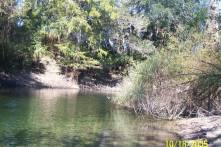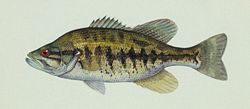|
The Suwannee Bass
The Suwannee Bass is the last of the fish species in the black bass family. As a member of this group, it is a very popular game fish that is chased by bass anglers throughout the Northern Florida and parts of Georgia. The Suwannee Bass is found only in the Suwannee and Ochlockonee River drainage of Florida and Georgia but it is thought that populations of the Suwannee have been introduced into the St. Marks and Wacissa rivers. The Suwannee prefers water that has a moving current in it. It can be found in shallow and rocky areas within this drainage area. Look for rocky areas in the smaller streams and pools. Although the Suwannee is on the list of fish species of special concerns. Which means that over fishing and declines of water quality could push them into decline. If water quality and ameliorate sources of degradation are monitored the threat can be seriously reduced. There has been a size limit of 12 inches in the Suwannee River and westward which should also help to protect Suwannee bass from over fishing by anglers.
DescriptionThe Suwannee Bass is a medium sized bass that will grow to roughly 16 inches in length. It is similar in coloration to the largemouth bass and its upper jaw extends to a point just below the eye. At about 1 year old the Suwannee will begin its breeding cycle and will devolop a bright and deep turquoise color on the cheek, breast and belly areas. The Suwannee bass is unique in that it has teeth on its tongue, while other members of the bass family usually do not. Male Suwannee bass are relatively smaller than the female and tend to grow to only about 1 pound. In comparison to a female which can grow to 16 inches and from 1 to 1 1/2 pounds and in rare circumstances even larger. The fish has dark blotches for lateral lines. The cheeks, breast and belly are a bright turquoise color. There is a very distinct black spot at the base of the tail and the jaw runs to the rear of the eye. Habitat
The Suwannee is found in rocky and sandy areas. They strive in streams, rivers, rocky areas, stumps and the sandy bottoms of the rivers and streams that they live in. They can be found in both still and moving water but do prefer the current. Like most fish, they are relatively intolerant of polluted water and will not survive unless water conditions improve in these rivers and streams. Like all game fish the Suwannee bass is a Carnivore and its diet mostly comprises of crayfish, insects, zooplankton and smaller fish.
HistoryThe Suwannee does prefer fast moving shoal areas with a limestone bottom which is often covered by sand. They generally prefer neutral or basic water such as those provided by springs coming in from the limestone aquifers. Although they can be found occasionally in the lower, tidally portions of the Suwannee River they have not been found in the upper portions where the acidic character of the Okefenokee Swamp dominates stream conditions. They appeared naturally in the Suwannee and Ochlockonee River systems of Florida and Georgia and are also plentiful in the lower portions of the Santa Fe River which is a tributary of the Suwannee River. The record is a 3 lb, 14.25 oz. fish caught in Florida's Suwannee River in March 1985.
Like all other members of the Black Bass Family of fish, the Suwanne should be enjoyed as a sport fish. By practicing catch and release and improvements in the water conditions where they call home this fish can thrive for years to come. I enjoy a nice meal of fish just as much as anyone, but there are many other more plentiful fish that can be enjoyed at the kitchen table. Put these fish back in the water and experience the enjoyment of catching them again another day. Maybe your grand children can experience them as well!!! One more cast... Return to Top of Suwannee Bass |


